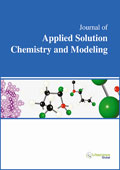jascm
 How to Resolve the Problem of Drago's Four Parameters in the Context of Molecular Interactions - Pages 7-15 How to Resolve the Problem of Drago's Four Parameters in the Context of Molecular Interactions - Pages 7-15Ho Nam Tran and Buchmann Michel DOI: https://doi.org/10.6000/1929-5030.2019.08.02 Published: 02 October 2019 |
Abstract: This study aims to provide a new thermodynamic method for determining the value of Drago's four interaction parameters, namely Ea, Eb, Ca, and Cb (kcal1/2 mol-1/2). The method is based on the following fundamental novelties: The values of the parameters Ea, Eb, Ca, and Cb are simultaneously determined for seven amphoteric substances. Thus, there are a total of 28 values to be determined, with each set consisting of seven substances. For the seven selected amphoteric substances, there are seven equations of the type: |
 The Free-Radical Nonbranched-Chain Initiated Formation of Ethylene Glycol from Methanol–Formaldehyde Solutions - Pages 1-5 The Free-Radical Nonbranched-Chain Initiated Formation of Ethylene Glycol from Methanol–Formaldehyde Solutions - Pages 1-5Michael M. Silaev DOI: https://doi.org/10.6000/1929-5030.2020.09.01 Published: 20 February 2020 |
Abstract: The mechanism and kinetics are developed for the free-radical nonbranched-chain initiated formation of ethylene glycol in methanol–formaldehyde solutions at formaldehyde concentrations of 0.1–3.1 mol dm–3 and temperatures of 373–473 K. The experimental concentrations of the free unsolvated form of formaldehyde are given at the different temperatures and total concentrations of formaldehyde in methanol. The experimental dependence of the radiation-chemical yields of ethylene glycol on formaldehyde concentration in γ-radiolysis of methanol–formaldehyde solutions at 373–473 K is shown. At a formaldehyde concentration of 1.4 mol dm–3 and T = 473 K, the radiation-chemical yield of ethylene glycol is 139 molecules per 100 eV. The effective activation energy of ethylene glycol formation is 25 ± 3 kJ mol–1. The quasi-steady-state treatment of the reaction network suggested here led to a rate equation accounting for the non-monotonic dependence of the ethylene glycol formation rate on the concentration of the free (unsolvated) form of dissolved formaldehyde. It is demonstrated that the peak in this dependence is due to the competition between methanol and CH2=O for reacting with adduct radical HOCH2CH2O•. |
|
|
Abstract: The last thirty years scientists carried out an active search of universal parameter of solvent C60 for predicting the solubility of fullerenes. However, this parameter was not found up to these days. In this paper it has been found an explanation of the impossibility of detection of such parameter. In present paper the features of the solubility of fullerene C60 molecules in nonpolar solvents have been studied. The molecule state diagram of the fullerene С60 molecules in solution at temperatures 265÷308 К and pressure range 1÷100 МPа, indicating the existence field of β- and γ-modifications, has been constructed. Moreover, it has been shown that in the solutions of fullerenes C60 in the γ-state the solubility decreases with a rise in temperature since the chemical activity of fullerene molecule increases. For this reason during extraction procedure the temperature rise causes the value of extraction rate to increase, but solubility – to decrease, i.e. to diminish the concentration of fullerenes molecules in the solvent volume. Keywords: Fullerene C60 molecule, molecule diagram, colloidal solution, solubility isobar, solutions classification. |
 To the Mathematical Theory of the Temkin Adsorption Model - Pages 6-12 To the Mathematical Theory of the Temkin Adsorption Model - Pages 6-12Michael Vigdorowitsch, Liudmila E. Tsygankova and Pavel N. Bernatsky DOI: https://doi.org/10.6000/1929-5030.2020.09.02 Published: 04 April 2020 |
Abstract: This study expands the mathematical theory of the Temkin adsorption model and demonstrates the way experimental data are to be additionally treated. A functional complement property of the Temkin isotherm has been studied as a particular case of the common theory of asymptotic complement. This property is shown to give rise to various analytical strategies to be employed for processing or interpretation of the experimental results, e.g. to perform mapping of data obtained in experiments onto a conjugated part of the true isotherm, to judge if presupposed energetic heterogeneity type of the surface really takes place, etc. Experimental data for adsorption of carbon monoxide on gold and of sodium oleate on steel with and without a magnetite coating have been extensively analysed. |
|
|
Abstract: The adsorption capacity of activated carbon modified with potassium permanganate(KMnO4) for rare earth elements (REEs) from aqueous solution was investigated. The modified activated carbon was characterized by SEM (scanning electron microscopy), FT-IR (Fourier transform infrared spectrometer), and N2 adsorption-desorption tests. Adsorption experiments from aqueous solutions containing known amounts of some REEs (i.e. La, Lu, Yb, Eu, Y, Sc) onto the carbon were explored in a batch system.The amount of REEsadsorbed at different pH values, initial concentrations, and contact times were determined by inductively coupled plasma-atomic emission spectrometry (ICP-AES) in order to determine the optimum conditions for REEs adsorption. The adsorption of REEs on the activated carbon was well fitted by the Langmuir isothermal adsorption equation. The rates of adsorption were found to conform to pseudo-second order kinetic. These results presentthe modified activated carbonas an efficient adsorbent for REEs, hence creating new avenues for the treatment of industrial waste waters including pollutants. It is very significant information from the viewpoint of environmental protection. Keyword: Adsorption, modified activated carbon, rare earth elements (REEs), adsorption isotherms, kinetics. |

